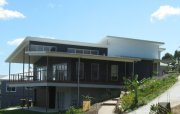TWEED COAST DESIGN and DRAFTING
Houses and Residential Units - Comprehensive design and drafting service.
Eco Green Designs
What makes a residence Green (ecologically sustainable and senstive)
For new buildings or renovation and/or extending an existing building.
Electricity costs have spiraled upwards in the last few years. Luckily, a few foward thinking companies realised this years ago and put money into research for alternative energy sources. Solar, wind and gas emerged as major sources of energy and as electricity became more expensive, they began to emerge as viable energy sources.
Alternative - Solar - Wind - Gas
There are many sources of alternative energy, but the most common ones used are Solar and Wind. Photovoltaic cells (which produce electricity) are built into a solar module, then the solar modules are grouped toghther to form a solar panel. These have a high manufacturing cost but easy to maintain and have virtually no running costs.
Wind driven turbines are also used to produce electricity. They have been widely used on boats and this technology is now being applied to land based applications. In low solar or high wind areas they are particularly viable. They are relatively cheap to make but can have an ongoing maintainence cost.
Gas (usually Liquid Petroleum ) is now a viable, cheap alternative energy for cooking and water heating.
Lights
A reasonable part of every energy bill for a house is for lights and do we really need that many lights in our homes. The more energy efficent the lights are, the lower the energy cost of running them. Look to alternative sources like solar powered or L.E.D. which use sigificaantly less energy.
Heating Water
This is usually the largest single energy use in the house. The most common energy saving device used is solar panel which uses sunlight to heat the water.
Heating/Cooling Systems
Heating - Use large masonary walls as heatsinks to radiate heat into the building and moveable shutters to allow the sun through during the cooler months.
Cooling - The most energy effective cooling system is the use of flow-through ventilation, large eaves to stop sunlight from reaching the building, high ceilings that allow the hot air to rise and ventilated roof spaces which allow the hot air to dissapate.
Energy Monitors
These allow you to see how much electrical energy is being used. You can program them to show energy use per day/week/month and also the monitor can be programed with the cost of the electricity which will give you the dollar amount of the electricity used.
Energy Creation - back into the grid
When you use solar panels or wind generators to create electricity, the excess electricity can be sold back to the electricity company and put into the electricity grid.
Electricity costs have spiraled upwards in the last few years. Luckily, a few foward thinking companies realised this years ago and put money into research for alternative energy sources. Solar, wind and gas emerged as major sources of energy and as electricity became more expensive, they began to emerge as viable energy sources.
Alternative - Solar - Wind - Gas
There are many sources of alternative energy, but the most common ones used are Solar and Wind. Photovoltaic cells (which produce electricity) are built into a solar module, then the solar modules are grouped toghther to form a solar panel. These have a high manufacturing cost but easy to maintain and have virtually no running costs.
Wind driven turbines are also used to produce electricity. They have been widely used on boats and this technology is now being applied to land based applications. In low solar or high wind areas they are particularly viable. They are relatively cheap to make but can have an ongoing maintainence cost.
Gas (usually Liquid Petroleum ) is now a viable, cheap alternative energy for cooking and water heating.
Lights
A reasonable part of every energy bill for a house is for lights and do we really need that many lights in our homes. The more energy efficent the lights are, the lower the energy cost of running them. Look to alternative sources like solar powered or L.E.D. which use sigificaantly less energy.
Heating Water
This is usually the largest single energy use in the house. The most common energy saving device used is solar panel which uses sunlight to heat the water.
Heating/Cooling Systems
Heating - Use large masonary walls as heatsinks to radiate heat into the building and moveable shutters to allow the sun through during the cooler months.
Cooling - The most energy effective cooling system is the use of flow-through ventilation, large eaves to stop sunlight from reaching the building, high ceilings that allow the hot air to rise and ventilated roof spaces which allow the hot air to dissapate.
Energy Monitors
These allow you to see how much electrical energy is being used. You can program them to show energy use per day/week/month and also the monitor can be programed with the cost of the electricity which will give you the dollar amount of the electricity used.
Energy Creation - back into the grid
When you use solar panels or wind generators to create electricity, the excess electricity can be sold back to the electricity company and put into the electricity grid.
email: tweedcoastdesign@gmail.com

 Tweed Coast Energy Assessments
Tweed Coast Energy Assessments